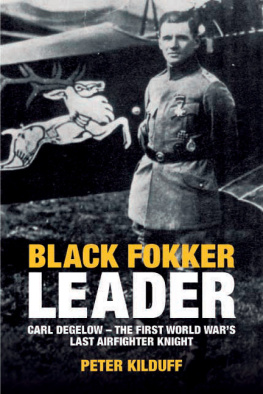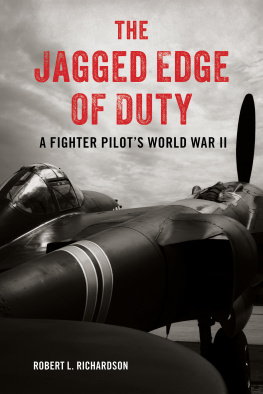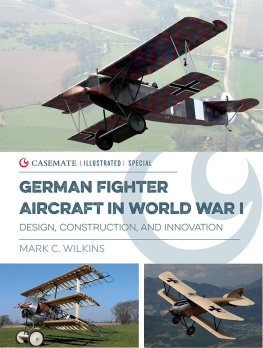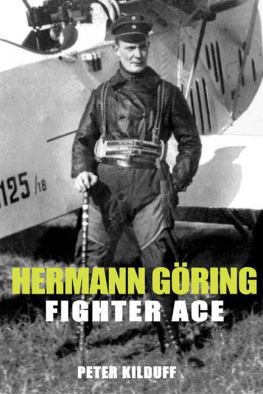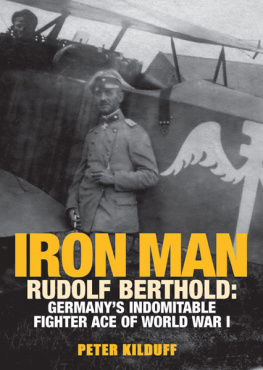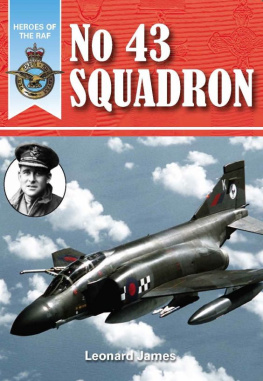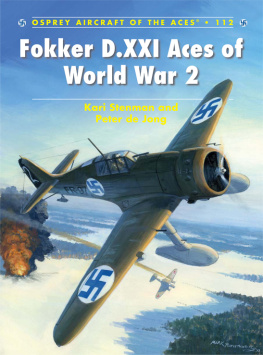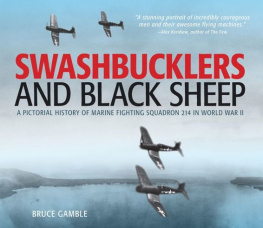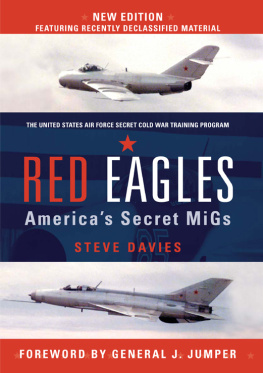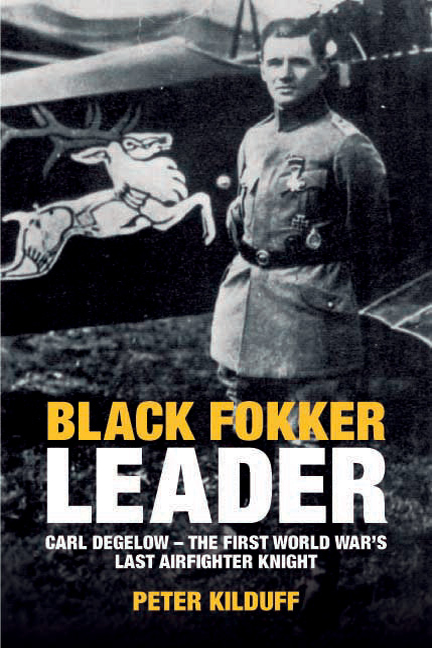
This book is dedicated to my support team:
Judy, Cara, Karl, Clayton, Christine, Elaine and Tessa Kilduffand Pearl
Other books by Peter Kilduff
The Red Baron
Thats My Bloody Plane
Germanys Last Knight of the Air
U.S. Carriers at War
A-4 Skyhawk
Germanys First Air Force 1914-1918
Richthofen Beyond the Legend of the Red Baron
Over the Battlefronts
The Red Baron Combat Wing
The Illustrated Red Baron
Talking With the Red Baron
Red Baron The Life and Death of an Ace

Published by
Grub Street Publishing
4 Rainham Close
West Midlands
London
SW11 6SS
Copyright Grub Street 2009
Copyright text Peter Kilduff 2009
British Library Cataloguing in Publication Data
Kilduff, Peter
Black Fokker leader: the First World Wars last airfighter knight
1. Degelow, Carl 2. Fighter pilots-Germany-Biography 3. World War, 1914-1918-Aerial operations, German 4. World War, 1914-1918-Campaigns-Western Front I. Title
940.44943092
ISBN-13: 9781906502287
eISBN: 9781908117847
All rights reserved. No part of this publication may be reproduced, stored in a retrieval system, or transmitted in any form or by any means electronic, mechanical, photocopying, recording, or otherwise, without the prior permission of the copyright owner.
Cover design by Lizzie B Design
Book design and artwork by:
Roy Platten, Eclipseroy.eclipse@btopenworld.com
Printed and bound by MPG Ltd, Bodmin, Cornwall
Grub Street Publishing uses only FSC (Forest Stewardship Council) paper for its books
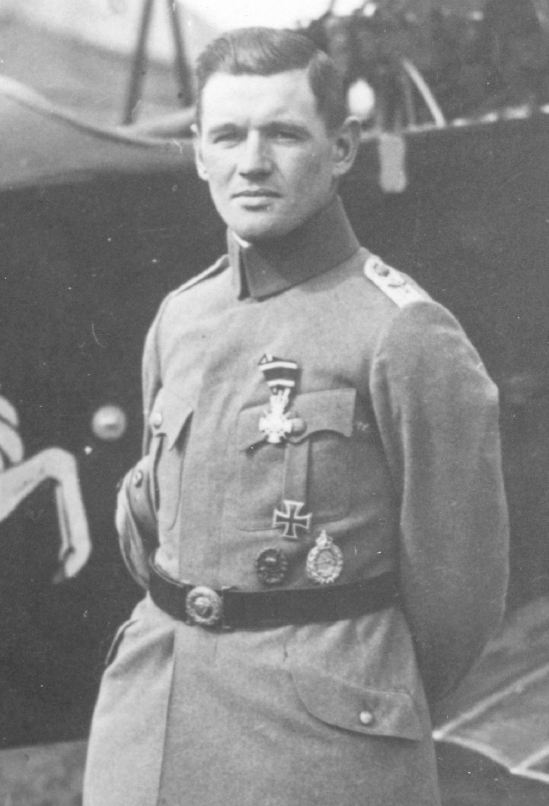
F OREWORD
In the summer of 1956, the novel The Falcons of France excited my fifteen-year-old mind in a way no book ever had. It recounted stories of idealistic and courageous young men who flew off to battle in the skies over France in biplanes made of wood and canvas. A thinly fictionalised account of the exploits of Charles Nordhoff and James Norman Hall as American volunteer pilots in the Lafayette Flying Corps, that 1929 book catalysed what has become a lifelong interest in World War I aviation history.
As my interest in the subject and book collection grew, one of the earliest titles I acquired was War Birds The Diary of an Unknown Aviator written by Elliott White Springs, with artwork by Clayton Knight; both men were Americans who flew with the Royal Air Force in World War I. In 1961, I had the good fortune to meet and become friends with Clayton Knight, OBE, and he was the first of nearly thirty surviving World War I flyers I came to know in person or by mail.
Each veteran flyer referred me to one or more of his living former comrades and in this way, in 1967, I was put in touch with Carl Degelow. I knew him by reputation as a thirty-victory ace and a recipient of the military order Pour le Mrite, Prussias (and, de facto , Germanys) highest award for bravery. It was a wonderful experience to correspond with him during the last three years of his life, during which he patiently indeed, enthusiastically answered my endless stream of questions. Carl Degelow was a living repository of history and I was determined to learn as much as I could about his air combat and other wartime experiences.
The initial result of our correspondence was the sixteen-page article Reminiscences of Jagdstaffel 40 in the Autumn 1971 issue of Cross & Cockade Journal , the quarterly publication of The Society of World War I Aero Historians. Unfortunately, Carl Degelow did not live to see the article, as he died on 9 November 1970 fifty-two years to the day after he was authorised to receive the last Pour le Mrite awarded during World War I. Eight years and more research later, a much expanded account of Degelows career appeared as my third book, Germanys Last Knight of the Air . Eventually the book went out of print, but my interest in Carl Degelow did not end. That enduring pursuit was best expressed in that 1979 book about him:
During the three years following our initial contact, [Degelows] letters to me were full of delightful anecdotes as well as unique photographs relating to his own or his comrades exploits. He wanted no barriers to stand in the way of a complete telling of his experiences during World War I. While I adhered to a rigid code of linguistic politeness so necessary for proper relationships in German correspondence, [Degelow] tossed it all off in one line of an early letter, done in English, as he liked to do from time to time: My friends all call me Charly, why not you, too?
In the following years, additional archival research revealed new information about Carl Degelow and his comrades, and brought me to a new review of the German-language texts used in the earlier book. It occurred to me that the new material, along with a fresh, edited translation of his letters and other texts, would enable me to tell a more complete story than before. By editing these texts, I believe I have made their tone as conversational as Degelows letters had been.
Moreover, the new material and a review of other documents clarified certain points in Degelows life story. For example, in recounting his unfortunate accident with another pilot in August 1917, Degelow identified the other man as Leutnant Kreuger, a name that does not appear on any rosters of the fighter squadron Jagdstaffel 36, to which both men belonged at the time. The summary of Jasta 36s war diary, which I obtained after my original Degelow article and book had been published, recorded the incident and identified the other man as Leutnant der Reserve Edwin Kreuzer, a native of the former Grand Duchy of Baden, which has since gained a special place in this authors heart. Thanks to material found in Badens central archive, an amended and expanded account of the accident appears in of this book.
In a war of vast destruction and savagery, Carl Degelow was notably different. While so many fighter pilots aimed specifically at their opposing pilots and aerial observers, Degelow took to heart the lesson offered by one of his instructors at the Fighter Pilot Training School: Aim for the aeroplane, not the man. When you put the aeroplane out of action, you will take care of the man. As difficult as it was to follow that admonition in the heat of combat, Carl Degelow did his best to achieve an unusual, humanistic approach to man-to-man air fighting and, consequently, he enjoyed the rare experience of greeting some of his aerial opponents in his Staffels dining room.
Far more meaningful than my words are those of Degelows long-time friend, the late Paul Nami. Pauls comments were published thirty years ago, but deserve to be read again, as they provide insight into a combatant who did not allow the exigencies of war to diminish his humanity:
Carl Degelows [exploits] as a German fighter pilot on the Western Front provides a clear picture of what goes on in a pilots mind when he is engaged in a life-or-death struggle in the air. Without such an account, it would be hard for people today to imagine what aerial combat was like during World War I. Performing the most disaster-laden manoeuvres in fabric-covered aircraft and flying without parachutes, the pilots of that era ran the daily risk of being set afire in the air or being hit in some vulnerable spot that would literally cause the airplane to break apart in the air, thousands of feet above the ground; add to these the dangers of shooting off ones own propeller if the machine gun synchronisation device malfunctioned, or having ones vision blurred by driving hail or rain in addition to the normal hazards of flying. One of the greatest risks was that of mid-air collision; for, even the slightest brushing of one speeding aeroplane against another would cause one or both aeroplanes to crash to the earth. It was a slight collision of this nature that caused the death of the celebrated German fighter pilot Oswald Boelcke.

